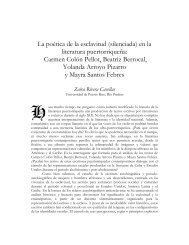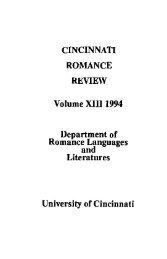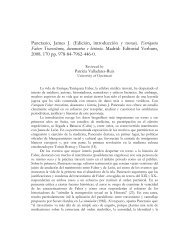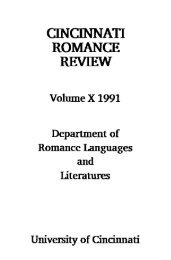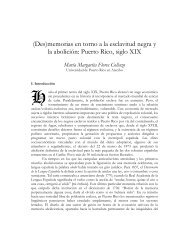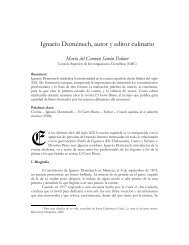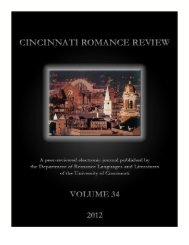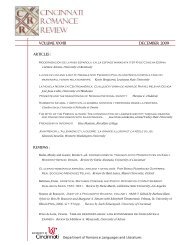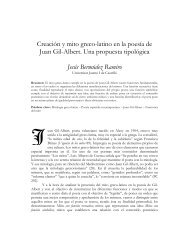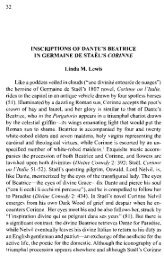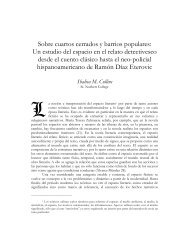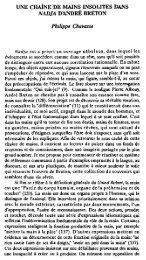Volume 30 (2011) - Cincinnati Romance Review
Volume 30 (2011) - Cincinnati Romance Review
Volume 30 (2011) - Cincinnati Romance Review
You also want an ePaper? Increase the reach of your titles
YUMPU automatically turns print PDFs into web optimized ePapers that Google loves.
(A)CERCAMIENTO AL CONCEPTO DE LA NEGRITUD 51<br />
su contexto sagrado y secular es una parte importante del acervo cultural nacional. A<br />
diferencia de la negritud cesariana y damasiana, la construcción de la identidad afrocolombiana<br />
pasa por la hibridación de la cultura. No es más un retorno a África ni un<br />
rechazo de la cultura occidental sino un enriquecimiento con el aporte cultura indígena y<br />
europeo. Es una identidad incluyente y tri-étnica. El efecto de la hibridación no consiste<br />
en rescatar al subalterno sino en desequilibrar y descentrar el factor hegemónico<br />
creando nuevos espacios y nuevas formas de poder, de saber y de ser. La hibridación<br />
produce un contradiscurso que tiene efecto de resistencia y antídoto contra el<br />
esencialismo, la univocidad y el control cultural, a la vez que pone de manifiesto la<br />
vitalidad de los grupos marginados (Cordones-Cook 651). La ideología de la negritud está<br />
muy presente en la literatura afro-colombiana pero con un sabor local. Como el tigre<br />
(del que habla Wole Soyinka), la literatura afro-colombiana no hace ostentación ni<br />
pompa de la negritud sino que se deja comprobar en sus acciones.<br />
OBRAS CITADAS<br />
Alaix de Valencia, Hortensia. La palabra poética del afro-colombiano. Cali: Litocencoa, 2003.<br />
Print.<br />
Artel, Jorge. Tambores en la noche. Bogotá: Plaza & Janes Editores Publication Date, 1986.<br />
Print.<br />
Ascroft, Bill, et al. The Post-Colonial Studies Reader. New York: Routledge, 1995. Print.<br />
Badiane, Mamadou. The Changing Face of Afro-Caribbean Cultural Identity: Negrismo and<br />
Negritude. Lanham: Lexington Books, 2010. Print.<br />
Certeau, Michel de. The Practice of Everyday Life. Berkeley: California U.P., 1986. Print.<br />
Cordones-Cook, Juanamaría. “Hibridez cultural/ Africanía religiosa en el Uruguay.”<br />
Revista Iberoamericana 65 (1999): 633-669. Print.<br />
Grueso Romero, María. El otro yo que sí soy. Poemas de amor y mar. Buenaventura:<br />
Ediciones Marymar 2003. Print.<br />
Guillén, Nicolás. Obra poética 1922-1977. La Habana: Ediciones Letras Cubanas, 1980.<br />
Print.<br />
Gutiérrez Azopardo, Ildefonso. Historia del negro en Colombia. Bogotá: Editorial Nueva<br />
América, 1986. Print.<br />
Janheinz, Jahn. The Muntu: The New African Culture. New York: Grove, 1961. Print.<br />
---. A History of Neo-African Literature. London: Faber, 1968. Print.<br />
Klor de Alba, Jorge. “Postcolonialization of the (Latin) American Experience: A<br />
Reconsideration of ‘Colonialism’ and ‘Mestizaje’.” After Colonialism: Imperial<br />
Histories and Postcolonial Displacements. Ed. Gyan Prakash. Princeton: U.P., 1995.<br />
Print.<br />
Kubayanda, Bekunuru. “The Linguistic Core of Afro-Hispanic Poetry: An African<br />
Reading.” Afro-Hispanic <strong>Review</strong> 3.1 (1982): 21-26. Print.<br />
<strong>Cincinnati</strong> <strong>Romance</strong> <strong>Review</strong> <strong>30</strong> (Winter <strong>2011</strong>): 39-52.



